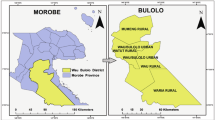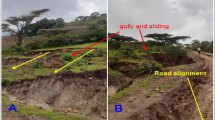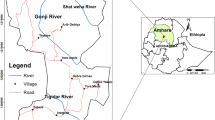Abstract
A spatial database of 791 landslides is analyzed using GIS to map landslide susceptibility in Tsugawa area of Agano River. Data from six landslide-controlling parameters namely lithology, slope gradient, aspect, elevation, and plan and profile curvatures are coded and inserted into the GIS. Later, an index-based approach is adopted both to put the various classes of the six parameters in order of their significance to the process of landsliding and weigh the impact of one parameter against another. Applying primary and secondary-level weights, a continuous scale of numerical indices is obtained with which the study area is divided into five classes of landslide susceptibility. Slope gradient and elevation are found to be important to delineate flatlands that will in no way be subjected to slope failure. The area which is at high scale of susceptibility lies on mid-slope mountains where relatively weak rocks such as sandstone, mudstone and tuff are outcropping as one unit.







Similar content being viewed by others
References
Aleotti P, Chowdhury R (1999) Landslide hazard assessment: summary review and new perspectives. Bull Eng Geol Environ 58:21–44
Ayalew L, Yamagishi H (2003) GIS-based landslide susceptibility mapping in Kakuda-Yahiko Mountains. In: Environmental science of the Mt. Yahiko-Mt. Kakuda and their surroundings. Report of the Yahiko Project, pp 67–84
Ayalew L, Yamagishi H (2004) Slope movements in the Blue Nile basin, as seen from landscape evolution perspective. Geomorphology 57:97–116
Chigira M (2003) Landslide hazard assessment by using AHP method in Minowayama area in the mid watershed of the Agano River. In: Abstract volume of the 42nd annual meeting of the Japan Landslide Society, Toyama, Japan, pp 221–222
Cruden DM, Varnes DJ (1996) Landslide types and processes. In: Turner AK, Schuster RL (eds) Landslides: investigation and mitigation, Transport Res Board Spec Rep 247, pp 36–75
Dai FC, Lee CF (2002) Landslide characteristics and slope instability modeling using GIS, Lantau Island, Hong Kong. Geomorphology 42:213–238
Friedman D, Diaconis P (1981) On the histograms of a density estimator L2 theory. Zeitschrift fur Wahrscheinlichkeitstheorie und Verwandte Gebiete 57:453–476
Guzzetti F, Carrara A, Cardinali M, Reichenbach P (1999) Landslide hazard evaluation: a review of current techniques and their application in a multi-scale study, Central Italy. Geomorphology 31:181–216
Hasegawa Y (1983) Surficial geological map of Tsugawa area (1:50000) with explanatory text. Niigata Prefecture, Niigata, 95 pp
Higaki D (2003) Detection of landslide hazardous slopes in the Kanose area, Central Japan by AHP method. In: Abstract volume of the 42nd annual meeting of the Japan Landslide Society, pp 217–220
Juang CH, Lee DH, Sheu C (1992) Mapping slope failure potential using fuzzy sets. J Geotech Eng 118(3):475–494
Lee S, Min K (2001) Statistical analysis of landslide susceptibility at Yongin, Korea. Environ Geol 40:1095–1113
Moore ID, Grayson RB, Ladson AR (1991) Digital terrain modeling: a review of hydrological, geomorphological and biological applications. Hydrolog Process 5:3–30
Saaty LT (1988) The analytic hierarchy process: planning, priority setting, resource allocation, RWS publications, Pittsburgh, 287 pp
Saaty LT (1994) Fundamentals of decision making and priority theory with analytic hierarchy process, RWS publications, Pittsburgh, 527 pp
Saaty LT, Vargas LG (2001) Models, methods, concepts, and applications of the analytic hierarchy process. Kluwer Academic, Boston, 333 pp
Scott DW (1979) On optimal and data-based histograms. Biometrika 66(3):605–610
Soeters R, van Westen CJ (1996) Slope instability recognition, analysis, and zonation. In: Turner AK, Schuster RL (eds) Landslides: investigation and mitigation. Transport Res Board Spec Rep 247, pp 129–177
Süzen ML, Doyuran V (2004) Data driven bivariate landslide susceptibility assessment using geographical information systems: a method and application to Asarsuyu Catchment, Turkey. Eng Geol 71:303–321
Uemura T, Yamada T (1988) Regional geology of Japan. Part 4, Chubu, Kyoritu Shuppan, Tokyo
Yagi H (2003) Development of assessment method for landslide hazardness by AHP. In: Abstract volume of the 42nd annual meeting of the Japan Landslide Society, pp 209–212
Author information
Authors and Affiliations
Corresponding author
Rights and permissions
About this article
Cite this article
Ayalew, L., Yamagishi, H. & Ugawa, N. Landslide susceptibility mapping using GIS-based weighted linear combination, the case in Tsugawa area of Agano River, Niigata Prefecture, Japan. Landslides 1, 73–81 (2004). https://doi.org/10.1007/s10346-003-0006-9
Received:
Accepted:
Published:
Issue Date:
DOI: https://doi.org/10.1007/s10346-003-0006-9




